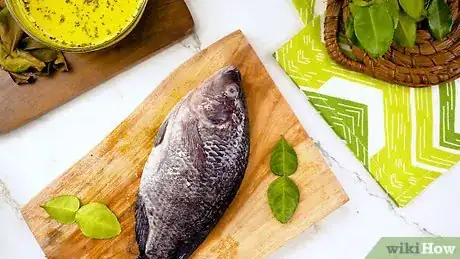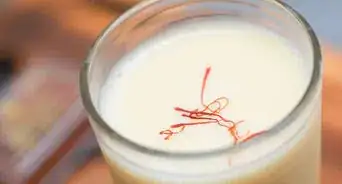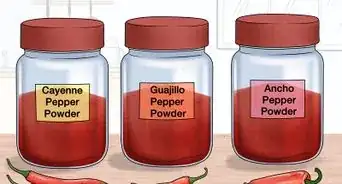This article was co-authored by wikiHow staff writer, Amy Bobinger. Amy Bobinger has been a writer and editor at wikiHow since 2017. She especially enjoys writing articles that help people overcome interpersonal hurdles but frequently covers a variety of subjects, including health and wellness, spirituality, gardening, and more. Amy graduated with a B.A. in English Lit from Mississippi College in 2011 and now lives in her hometown with her husband and two young sons.
There are 10 references cited in this article, which can be found at the bottom of the page.
The wikiHow Video Team also followed the article's instructions and verified that they work.
This article has been viewed 464,195 times.
Learn more...
Whether you're looking for a new, exciting ingredient to add to your dishes or you want to recreate some of your favorite Thai dishes at home, kaffir lime leaves might be just the ticket. The leaves of the kaffir lime tree are doubled, so they almost look like two leaves put together end-to-end. You can find fresh leaves at some Asian markets, but if those aren't available, you can use dried leaves, which are often easier to source.
Things You Should Know
- Toss whole leaf pieces into dishes as you're cooking for a bright, citrusy flavor. Remove the leaves before serving the dish.
- Slice fresh leaves finely before incorporating them in a dish. You don't need to remove chopped kaffir lime leaves before serving the dish.
- The flavor of kaffir lime leaves pairs well with Thai dishes, seafood, shellfish, rice, and citrus desserts.
Steps
Preparing and Storing Fresh Leaves
-
1Tear the rib from fresh leaves, then add them to your dish. First, fold your fresh kaffir lime leaf in half along the rib, which is the woody part running lengthwise down the leaf. Then, pinch the tip of the rib and pull downward to tear it from the leaf. Once you've removed the rib, toss the remaining leaf pieces into a dish as it's cooking to impart a bright, citrusy flavor.[1]
- Tearing the leaf helps release some of its fragrance and flavor. You can also crush the leaf to bruise it for a stronger flavor.
- Fresh kaffir lime leaves can be used in a variety of recipes, including soups, curries, and noodle dishes.
-
2Remove the whole leaves before you serve the dish. Kaffir lime leaves are fairly tough and difficult to eat. If you put whole kaffir lime leaves into your recipe while it's cooking, make sure to pull them out before you serve the dish.[2]
- If you prefer, you can leave them in your food, then just eat around them.
Advertisement -
3Slice the leaves finely to include them throughout your dish. If you don't want to remove the leaves from your dish, either cut or tear away the spine from the leaves, then stack the leaf pieces together and roll them tightly in a cylinder. Place the cylinder on a cutting board, then use a small, sharp knife to slice the leaves as thinly as possible.[3]
- This is great for incorporating the kaffir lime flavor into salads, noodles, or rice dishes, or to use the leaves as a garnish.
-
4Store fresh leaves in the refrigerator for 2 weeks. As with any fresh herb, you'll need to refrigerate your fresh leaves to help them retain their color and flavor. Place them in a resealable plastic bag or an airtight container, then put them in your refrigerator for 14 days, or longer if they still have a firm texture and deep green color.[4]
- If you don't think you'll use the leaves in time, you can freeze them for up to a year. Just put them in a freezer bag and squeeze out as much air as you can without crushing the leaves. Then, label the bag and place it in the freezer until you need it. You can defrost the leaves by leaving them at room temperature for 20-30 minutes.[5]
Using Dried or Powdered Leaves
-
1Simmer dried leaves in your dish to impart their flavor. You can use dried kaffir lime leaves the same way that you would if they were fresh. Fold the leaf in half and pinch the stem, then tear it from the leaf. Drop the leaf in your dish as it's cooking, then pull out the pieces of leaf before you serve the food.[6]
- Use the same ratio of fresh or dried leaves. For instance, if your recipe calls for 1 fresh kaffir lime leaf, you could use 1 dried leaf, instead.
- When you're choosing dried kaffir leaves, make sure they still look green. If they look grey, they're too old, although it's okay if they're a little faded.[7]
-
2Eat around the dried leaves or remove them before you serve your food. Dried kaffir lime leaves are tough, and they're difficult to chew. If you leave them in the dish, push them to the side of the plate or bowl while you're eating.[8]
- You can also use a slotted spoon to scoop out the leaves before serving the dish.
-
3Sprinkle a pinch of kaffir leaf powder into a dish to add a subtle flavor. You may be able to find dried kaffir lime powder in some well-stocked markets. If you have this, you can take just a pinch of the powder and add it to your dish as it's cooking. The granules of leaves will soften as they cook, so you don't have to worry about removing them from your food.[9]
- For instance, you might sprinkle in the granules to add a tangy flavor to your stir fry.
Including the Leaves in Specific Dishes
-
1Pair kaffir lime leaves with other Thai flavors. In the culinary world, there's a common saying: "What grows together goes together." That means that typically, ingredients from the same region or cuisine will complement each other in a dish. Whether you're creating a dish from scratch or you're just looking for a recipe you could incorporate your lime leaves into, try adding the kaffir lime leaves to dishes including ingredients like galangal, lemongrass, chilies, ginger, shallots, and coriander leaves.[10]
- For instance, you might use kaffir lime leaves in authentic Thai dishes such as Make Tom Yum or Tom Kha, panang, rice noodle salad, or Tod Mun, which is a fried fish cake.
Did You Know? Although the flavors are slightly different, you can use kaffir lime leaves as a substitute for lemongrass, and vice versa.[11]
-
2Try adding kaffir lime leaves to fish and shellfish dishes. Citrus is a natural complement to fish and seafood, so it only makes sense that the kaffir lime leaf would also pair nicely with these foods. For instance, you might toss in a leaf while you're sauteeing shrimp, or you might sprinkle julienned leaves onto a piece of fish before you grill it.[12]
- For a healthy, convenient option, try placing a kaffir lime leaf in a foil packet when you're baking frozen tilapia.
- The tart flavor would also be a nice addition to a dish like steamed clams or steamed fish. Just toss a leaf or two in the water before you bring it to a boil!
-
3Add kaffir lime leaves to add a bright citrus flavor to curry. Thai-style curries often use kaffir lime leaves, so if you've been searching for that elusive flavor that would make your homemade curry taste like your favorite take-out, this might be the trick! Just simmer 1 whole leaf in the dish, then either remove the leaf before you serve the curry or just eat around it. [13]
- This is especially good in a light, refreshing coconut curry.
-
4Use the lime leaves to give your rice an extra layer of flavor. When you're simmering rice, add a fresh or dried kaffir lime leaf. The leaf will infuse the rice with tart, herbal notes, which will add extra complexity to any dish.[14]
- This rice would pair especially well with a fish or seafood soup, like Shrimp in Sour Soup or seafood stew.
-
5Add the leaves to a sweet dish to make a citrusy dessert. Kaffir lime leaves don't just have to be used in a savory dish. You can infuse them into milk, cream, butter, or sugar syrup, then mix that into your dessert. However, you can also incorporate the julienned leaves or kaffir lime leaf granules into your dish for a stronger flavor.[15]
- For instance, you might use julienned kaffir lime leaves as a garnish for a bowl of ice cream, or you could incorporate them into a cheesecake to add a tart, bright flavor.
- You can also use your infused sugar syrup in drinks, including lemonade, tea, or cocktails.[16]
Finding Other Uses
-
1Add a few leaves to your potpourri to add a citrus aroma. If you enjoy making homemade potpourri, consider adding kaffir lime leaves to your next batch! All you have to do is crush the leaves to bruise them to release their fragrant oils.
- For instance, you might mix dried orange peels, vanilla pods, kaffir lime leaves, and sandalwood to create a rich, bright fragrance.
-
2Place the leaves in your bath to add a pleasant scent. A bath that's scented with citrus can be very relaxing, but the bright fragrance can also invigorate your mood. Try dropping 2-3 leaves in the water before you soak in a hot bath. Then, just relax in your bath and enjoy the aroma!
- You may want to crush the leaves first to allow them to release more of their fragrance.
-
3Rub the leaves on your skin as a natural perfume. If you're looking for an all-natural way to freshen up, try crushing or tearing a kaffir lime leaf. Then, rub it on your pulse points, such as at your wrists or the base of your neck. The oils from the leaf will transfer to your skin, leaving behind a subtle, citrusy scent. [17]
- The scent of kaffir lime leaves may also be effective as a mosquito repellent.
- Although kaffir lime leaves are not considered to be a skin irritant, if you notice that your skin seems red or itchy after you tried this, rinse the area with cool water and don't apply the leaves to your skin anymore.
-
4Tuck the leaves into a wreath to add a pleasant aroma. A scented wreath is a beautiful way to welcome guests to your home. Depending on the style of your wreath, you may be able to tuck the leaves into your wreath without securing them. However, if they won't stay, you can wrap wire around the thinnest part of the leaf, in the middle, then secure the wire to your wreath.[18]
Warning: Due to the possible spread of citrus diseases, it is against the law to move kaffir lime leaves (or items that contain them) into or out of Alabama, American Samoa, Arizona, California, Florida, Georgia, Guam, Hawaii, Louisiana, Mississippi, Northern Mariana Islands, Puerto Rico, South Carolina, Texas, and the US Virgin Islands.
Community Q&A
-
QuestionCan I eat the limes themselves?
 Community AnswerYes, you can. Try boiling them in a pot of water over an open flame, with sea salt and coffee extract.
Community AnswerYes, you can. Try boiling them in a pot of water over an open flame, with sea salt and coffee extract. -
QuestionWhat is a good substitute?
 Community AnswerYou can use 1/2 of a small bay leaf, 1/4 tsp. of lime zest, or 1/8 tsp. of fresh lemon thyme.
Community AnswerYou can use 1/2 of a small bay leaf, 1/4 tsp. of lime zest, or 1/8 tsp. of fresh lemon thyme. -
QuestionWhat can I use the limes for?
 Community AnswerWhitening underarms and reducing body odour, solving dandruff problems...it's generally good for the scalp as well.
Community AnswerWhitening underarms and reducing body odour, solving dandruff problems...it's generally good for the scalp as well.
References
- ↑ https://www.thaitable.com/thai/ingredient/kaffir-lime-leaves
- ↑ bbc.co.uk/food/lime_leaves
- ↑ bbc.co.uk/food/lime_leaves
- ↑ https://www.thaitable.com/thai/ingredient/kaffir-lime-leaves
- ↑ https://www.vegetariantimes.com/recipes/what-do-i-do-with-kaffir-lime-leaves
- ↑ bbc.co.uk/food/lime_leaves
- ↑ https://www.kindearth.net/thai-coconut-curry-with-kaffir-lime-leaves-and-butternut-squash/
- ↑ bbc.co.uk/food/lime_leaves
- ↑ https://youtu.be/ja3RPsrBxgU?t=251
- ↑ https://youtu.be/ja3RPsrBxgU?t=140
- ↑ https://www.kindearth.net/thai-coconut-curry-with-kaffir-lime-leaves-and-butternut-squash/
- ↑ https://www.bbc.co.uk/food/lime_leaves
- ↑ https://www.kindearth.net/thai-coconut-curry-with-kaffir-lime-leaves-and-butternut-squash/
- ↑ https://www.vegetariantimes.com/recipes/what-do-i-do-with-kaffir-lime-leaves
- ↑ https://www.greatbritishchefs.com/how-to-cook/how-to-cook-with-kaffir-lime-leaves
- ↑ http://blog.seasonwithspice.com/2012/03/simple-kaffir-lime-leaves-recipes.html
- ↑ http://blog.seasonwithspice.com/2012/03/simple-kaffir-lime-leaves-recipes.html
- ↑ http://blog.seasonwithspice.com/2012/03/simple-kaffir-lime-leaves-recipes.html
About This Article
To use Kaffir lime leaves, you can add whole leaves, either dried or fresh, to Asian soups, curries, and rice dishes while they're simmering to impart a distinct flavor. Shred the dried leaves before adding them to fish cakes and be sure to use fresh, tender leaves for salads. Remember that this highly aromatic leaf is mostly used for flavor and is rarely eaten whole in dishes. For tips on using the leaves to scent a bath or create potpourri, read on!






























































